Biodegradable Block Poly(ester amine)s with Pendant Hydroxyl Groups for Biomedical Applications
Abstract
1. Introduction
2. Materials and Methods
2.1. Materials
2.2. Synthesis of Dimethyl 2,3-O-Isopropylidene-l-tartrate
2.3. Synthesis of Tert-Butyl Bis(2-hydroxyethyl) Carbamate (Boc-DEA) and N,N′-Ethane-1,2-diylbis[N-(2-hydroxyethyl)-2,2-dimethylpropanamide](Boc2-HEDA): Procedures for Blocking Secondary Amine Groups in Diethanolamine and N,N′-bis (2 Hydroxyethyl) Ethylenediamine
2.4. Synthesis of Polyester Macroinitiators; Poly(butylene 2,3-O-isopropylidene-l-tartrate), Poly(tert-butyl-bis(2-hydroxyethyl) Carbamate 2,3-O-Isopropylidene-l-tartrate) and Poly(N,N′-ethane -1,2-diylbis[N-(2-hydroxyethyl)-2,2-dimethylpropanamide,3-O-Isopropylidene-l-tartrate)
2.5. Copolymerization of L-Lactide with Glycolide in the Presence of Macroinitiators
2.6. Conditions and Course of Deprotection of Amino and Hydroxyl Groups in Copolymers
2.7. Measurements
2.7.1. Nuclear Magnetic Resonance (NMR) Spectroscopy
2.7.2. Thermal Properties
2.7.3. Fourier Transform Infrared (FTIR) Spectroscopy
2.7.4. Measurement of Average Molecular Mass and Mass Dispersion
2.7.5. Determination of the Amount of Active Hydroxyl Groups in Obtained Polymers
2.7.6. Wettability
3. Results and Discussion
3.1. Obtaining Polyesteramines and Polyesters-Macroinitiators of Copolymerization of Lactide with Glycolide
3.2. Synthesis of Block Terpolymers by Copolymerization of L-Lactide with Glycolide in the Presence of Obtained Polyesteramines or Polyesters as Macroinitiators
3.3. FTIR Spectroscopy Results
3.4. Static Contact Angle Measurements
3.5. Average Molecular Weight Measurements
3.6. Thermal Properties of the Terpolymers
4. Conclusions
Supplementary Materials
Author Contributions
Funding
Institutional Review Board Statement
Informed Consent Statement
Data Availability Statement
Conflicts of Interest
References
- Ulery, B.D.; Nair, L.S.; Laurencin, C.T. Biomedical Applications of Biodegradable Polymers. J. Polym. Sci. Part B Polym. Phys. 2011, 49, 832–864. [Google Scholar] [CrossRef]
- Bayan, M.F.; Marji, S.M.; Salem, M.S.; Begum, M.Y.; Chidambaram, K.; Chandrasekaran, B. Development of Polymeric-Based Formulation as Potential Smart Colonic Drug Delivery System. Polymers 2022, 14, 3697. [Google Scholar] [CrossRef]
- Sung, Y.K.; Kim, S.W. Recent Advances in Polymeric Drug Delivery Systems. Biomater. Res. 2020, 24, 12. [Google Scholar] [CrossRef] [PubMed]
- Sharma, U.; Concagh, D.; Core, L.; Kuang, Y.; You, C.; Pham, Q.; Zugates, G.; Busold, R.; Webber, S.; Merlo, J.; et al. The Development of Bioresorbable Composite Polymeric Implants with High Mechanical Strength. Nat. Mater. 2018, 17, 96–103. [Google Scholar] [CrossRef] [PubMed]
- Prabhu, B.; Karau, A.; Wood, A.; Dadsetan, M.; Liedtke, H.; DeWitt, T. Bioresorbable Materials for Orthopedic Applications (Lactide and Glycolide Based). In Orthopedic Biomaterials: Progress in Biology, Manufacturing, and Industry Perspectives; Li, B., Webster, T., Eds.; Springer International Publishing: Cham, Switzerland, 2018; pp. 287–344. ISBN 978-3-319-89542-0. [Google Scholar]
- Pillai, C.K.S.; Sharma, C.P. Review Paper: Absorbable Polymeric Surgical Sutures: Chemistry, Production, Properties, Biodegradability, and Performance. J. Biomater. Appl. 2010, 25, 291–366. [Google Scholar] [CrossRef] [PubMed]
- Ammala, A. Biodegradable Polymers as Encapsulation Materials for Cosmetics and Personal Care Markets. Int. J. Cosmet. Sci. 2013, 35, 113–124. [Google Scholar] [CrossRef]
- Group, S.M. Sterilization of Bioresorbable Polymers. Available online: https://www.medicaldesignbriefs.com/component/content/article/mdb/pub/briefs/17160 (accessed on 1 December 2022).
- Orapiriyakul, W.; Young, P.S.; Damiati, L.; Tsimbouri, P.M. Antibacterial Surface Modification of Titanium Implants in Orthopaedics. J. Tissue Eng. 2018, 9, 2041731418789838. [Google Scholar] [CrossRef]
- Li, D.; Lv, P.; Fan, L.; Huang, Y.; Yang, F.; Mei, X.; Wu, D. The Immobilization of Antibiotic-Loaded Polymeric Coatings on Osteoarticular Ti Implants for the Prevention of Bone Infections. Biomater. Sci. 2017, 5, 2337–2346. [Google Scholar] [CrossRef]
- Al-Halaseh, L.K.; Al-Adaileh, S.; Mbaideen, A.; Hajleh, M.N.A.; Al-Samydai, A.; Zakaraya, Z.Z.; Dayyih, W.A. Implication of Parabens in Cosmetics and Cosmeceuticals: Advantages and Limitations. J. Cosmet. Dermatol. 2022, 21, 3265–3271. [Google Scholar] [CrossRef]
- Arslan, I. Trends in Antimicrobial Resistance in Healthcare-Associated Infections: A Global Concern. In Encyclopedia of Infection and Immunity; Rezaei, N., Ed.; Elsevier: Oxford, UK, 2022; pp. 652–661. ISBN 978-0-323-90303-5. [Google Scholar]
- Anand, S.P.; Sati, N. Artificial preservatives and their harmful effects: Looking toward nature for safer alternatives. Int. J. Pharm. Sci. Res. 2013, 4, 2496–2501. [Google Scholar]
- Hancock, R.E.W.; Sahl, H.-G. Antimicrobial and Host-Defense Peptides as New Anti-Infective Therapeutic Strategies. Nat. Biotechnol. 2006, 24, 1551–1557. [Google Scholar] [CrossRef]
- Takahashi, H.; Palermo, E.F.; Yasuhara, K.; Caputo, G.A.; Kuroda, K. Molecular Design, Structures, and Activity of Antimicrobial Peptide-Mimetic Polymers. Macromol. Biosci. 2013, 13, 1285–1299. [Google Scholar] [CrossRef]
- Škrlová, K.; Rybková, Z.; Stachurová, T.; Zagora, J.; Malachová, K.; Měřinská, D.; Gabor, R.; Havlíček, M.; Muñoz-Bonilla, A.; Fernández-García, M.; et al. Long-Term Antimicrobial Effect of Polylactide-Based Composites Suitable for Biomedical Use. Polym. Test. 2022, 116, 107760. [Google Scholar] [CrossRef]
- Bayraktar, I.; Doganay, D.; Coskun, S.; Kaynak, C.; Akca, G.; Unalan, H.E. 3D Printed Antibacterial Silver Nanowire/Polylactide Nanocomposites. Compos. Part B Eng. 2019, 172, 671–678. [Google Scholar] [CrossRef]
- Ueng, S.W.N.; Lin, S.-S.; Wang, I.-C.; Yang, C.-Y.; Cheng, R.-C.; Liu, S.-J.; Chan, E.-C.; Lai, C.-F.; Yuan, L.-J.; Chan, S.-C. Efficacy of Vancomycin-Releasing Biodegradable Poly(Lactide-Co-Glycolide) Antibiotics Beads for Treatment of Experimental Bone Infection Due to Staphylococcus Aureus. J. Orthop. Surg. 2016, 11, 52. [Google Scholar] [CrossRef]
- Barczyńska-Felusiak, R.; Pastusiak, M.; Rychter, P.; Kaczmarczyk, B.; Sobota, M.; Wanic, A.; Kaps, A.; Jaworska-Kik, M.; Orchel, A.; Dobrzyński, P. Synthesis of the Bacteriostatic Poly(l-Lactide) by Using Zinc (II)[(Acac)(L)H2O] (L = Aminoacid-Based Chelate Ligands) as an Effective ROP Initiator. Int. J. Mol. Sci. 2021, 22, 6950. [Google Scholar] [CrossRef]
- Xie, Y.; Liao, X.; Zhang, J.; Yang, F.; Fan, Z. Novel Chitosan Hydrogels Reinforced by Silver Nanoparticles with Ultrahigh Mechanical and High Antibacterial Properties for Accelerating Wound Healing. Int. J. Biol. Macromol. 2018, 119, 402–412. [Google Scholar] [CrossRef]
- Xue, H.; Hu, L.; Xiong, Y.; Zhu, X.; Wei, C.; Cao, F.; Zhou, W.; Sun, Y.; Endo, Y.; Liu, M.; et al. Quaternized Chitosan-Matrigel-Polyacrylamide Hydrogels as Wound Dressing for Wound Repair and Regeneration. Carbohydr. Polym. 2019, 226, 115302. [Google Scholar] [CrossRef] [PubMed]
- Zhang, Y.; Dang, Q.; Liu, C.; Yan, J.; Cha, D.; Liang, S.; Li, X.; Fan, B. Synthesis, Characterization, and Evaluation of Poly(Aminoethyl) Modified Chitosan and Its Hydrogel Used as Antibacterial Wound Dressing. Int. J. Biol. Macromol. 2017, 102, 457–467. [Google Scholar] [CrossRef] [PubMed]
- Madruga, L.Y.C.; Popat, K.C.; Balaban, R.C.; Kipper, M.J. Enhanced Blood Coagulation and Antibacterial Activities of Carboxymethyl-Kappa-Carrageenan-Containing Nanofibers. Carbohydr. Polym. 2021, 273, 118541. [Google Scholar] [CrossRef] [PubMed]
- Alencar-Silva, T.; Braga, M.C.; Santana, G.O.S.; Saldanha-Araujo, F.; Pogue, R.; Dias, S.C.; Franco, O.L.; Carvalho, J.L. Breaking the Frontiers of Cosmetology with Antimicrobial Peptides. Biotechnol. Adv. 2018, 36, 2019–2031. [Google Scholar] [CrossRef] [PubMed]
- Gelman, M.A.; Weisblum, B.; Lynn, D.M.; Gellman, S.H. Biocidal Activity of Polystyrenes That Are Cationic by Virtue of Protonation. Org. Lett. 2004, 6, 557–560. [Google Scholar] [CrossRef]
- Schmitt, M.A.; Weisblum, B.; Gellman, S.H. Unexpected Relationships between Structure and Function in α,β-Peptides: Antimicrobial Foldamers with Heterogeneous Backbones. J. Am. Chem. Soc. 2004, 126, 6848–6849. [Google Scholar] [CrossRef] [PubMed]
- Zhang, H.; Vinogradov, S.V. Short Biodegradable Polyamines for Gene Delivery and Transfection of Brain Capillary Endothelial Cells. J. Control. Release 2010, 143, 359–366. [Google Scholar] [CrossRef]
- Douglas, E.J.A.; Alkhzem, A.H.; Wonfor, T.; Li, S.; Woodman, T.J.; Blagbrough, I.S.; Laabei, M. Antibacterial Activity of Novel Linear Polyamines against Staphylococcus Aureus. Front. Microbiol. 2022, 13, 948343. [Google Scholar] [CrossRef] [PubMed]
- Zhou, J.; Liu, J.; Cheng, C.J.; Patel, T.R.; Weller, C.E.; Piepmeier, J.M.; Jiang, Z.; Saltzman, W.M. Biodegradable Poly(Amine-Co-Ester) Terpolymers for Targeted Gene Delivery. Nat. Mater. 2011, 11, 82–90. [Google Scholar] [CrossRef] [PubMed]
- Liu, J.; Jiang, Z.; Zhou, J.; Zhang, S.; Saltzman, W.M. Enzyme-Synthesized Poly(Amine-Co-Esters) as Nonviral Vectors for Gene Delivery. J. Biomed. Mater. Res. A 2011, 96, 456–465. [Google Scholar] [CrossRef]
- Jiang, Y.; Gaudin, A.; Zhang, J.; Agarwal, T.; Song, E.; Kauffman, A.C.; Tietjen, G.T.; Wang, Y.; Jiang, Z.; Cheng, C.J.; et al. A “Top-down” Approach to Actuate Poly(Amine-Co-Ester) Terpolymers for Potent and Safe MRNA Delivery. Biomaterials 2018, 176, 122–130. [Google Scholar] [CrossRef]
- Dhamaniya, S.; Das, D.; Satapathy, B.K.; Jacob, J. Influence of Block Composition on Structural, Thermal and Mechanical Properties of Novel Aliphatic Polyester Based Triblock Copolymers. Polymer 2012, 53, 4662–4671. [Google Scholar] [CrossRef]
- Dhamaniya, S.; Jacob, J. Synthesis and Characterization of Polyesters Based on Tartaric Acid Derivatives. Polymer 2010, 51, 5392–5399. [Google Scholar] [CrossRef]
- Dhamaniya, S.; Jaggi, H.S.; Nimiya, M.; Sharma, S.; Satapathy, B.K.; Jacob, J. Synthesis, Characterization and Biodegradation Studies of Chain-Coupled Polyesters Based on Tartaric Acid. Polym. Int. 2014, 63, 680–688. [Google Scholar] [CrossRef]
- Zakharova, E.; Martínez de Ilarduya, A.; León, S.; Muñoz-Guerra, S. Hydroxyl-Functionalized Amphiphilic Triblock Copolyesters Made of Tartaric and Lactic Acids: Synthesis and Nanoparticle Formation. React. Funct. Polym. 2018, 126, 52–62. [Google Scholar] [CrossRef]
- Regaño, C.; Martínez De Ilarduya, A.; Iribarren, J.I.; Muñoz-Guerra, S. Poly(Ester Amide)s Derived from L-Tartaric Acid and Amino Alcohols. II. Aregic Polymers. J. Polym. Sci. Part Polym. Chem. 2000, 38, 2687–2696. [Google Scholar] [CrossRef]
- Wu, R.; AL-Azemi, T.F.; Bisht, K.S. One-Shot Block Copolymerization of a Functional Seven-Membered Cyclic Carbonate Derived from l-Tartaric Acid with ε-Caprolactone. Macromolecules 2009, 42, 2401–2410. [Google Scholar] [CrossRef]
- Williams, R.M.; Sinclair, P.J.; DeMong, D.E.; Chen, D.; Zhai, D. Asymmetric synthesis of n-tert-butoxycarbonyl a-amino acids. synthesis of (5S,6R)-4-tert-butoxycarbonyl-5,6-diphenylmorpholin-2-one. Org. Synth. 2003, 80, 18. [Google Scholar] [CrossRef]
- Sartori, G.; Ballini, R.; Bigi, F.; Bosica, G.; Maggi, R.; Righi, P. Protection (and Deprotection) of Functional Groups in Organic Synthesis by Heterogeneous Catalysis. Chem. Rev. 2004, 104, 199–250. [Google Scholar] [CrossRef] [PubMed]
- Pham, P.; Oliver, S.; Wong, E.H.H.; Boyer, C. Effect of Hydrophilic Groups on the Bioactivity of Antimicrobial Polymers. Polym. Chem. 2021, 12, 5689–5703. [Google Scholar] [CrossRef]
- Dhamaniya, S.; Jacob, J. Synthesis and Characterization of Copolyesters Based on Tartaric Acid Derivatives. Polym. Bull. 2012, 68, 1287–1304. [Google Scholar] [CrossRef]
- Śmigiel-Gac, N.; Pamuła, E.; Krok-Borkowicz, M.; Smola-Dmochowska, A.; Dobrzyński, P. Synthesis and Properties of Bioresorbable Block Copolymers of L-Lactide, Glycolide, Butyl Succinate and Butyl Citrate. Polymers 2020, 12, 214. [Google Scholar] [CrossRef]
- Gandini, A.; Silvestre, A.J.D.; Neto, C.P.; Sousa, A.F.; Gomes, M. The Furan Counterpart of Poly(Ethylene Terephthalate): An Alternative Material Based on Renewable Resources. J. Polym. Sci. Part Polym. Chem. 2009, 47, 295–298. [Google Scholar] [CrossRef]
- Smola, A.; Dobrzynski, P.; Cristea, M.; Kasperczyk, J.; Sobota, M.; Gebarowska, K.; Janeczek, H. Bioresorbable Terpolymers Based on L-Lactide, Glycolide and Trimethylene Carbonate with Shape Memory Behaviour. Polym. Chem. 2014, 5, 2442–2452. [Google Scholar] [CrossRef]
- Dobrzynski, P.; Kasperczyk, J.; Janeczek, H.; Bero, M. Synthesis of Biodegradable Copolymers with the Use of Low Toxic Zirconium Compounds. 1. Copolymerization of Glycolide with l-Lactide Initiated by Zr(Acac)4. Macromolecules 2001, 34, 5090–5098. [Google Scholar] [CrossRef]
- Kuo, S.-W. Hydrogen-Bonding in Polymer Blends. J. Polym. Res. 2008, 15, 459–486. [Google Scholar] [CrossRef]
- Girard, C.; Gupta, M.; Lallam, A.; Anokhin, D.V.; Bovsunovskaya, P.V.; Akhyamova, A.F.; Melnikov, A.P.; Piryazev, A.A.; Rodygin, A.I.; Rychkov, A.A.; et al. Synthesis and Characterization of Poly(Ester Amide Amide)s of Different Alkylene Chain Lengths. Polym. Bull. 2019, 76, 495–509. [Google Scholar] [CrossRef]
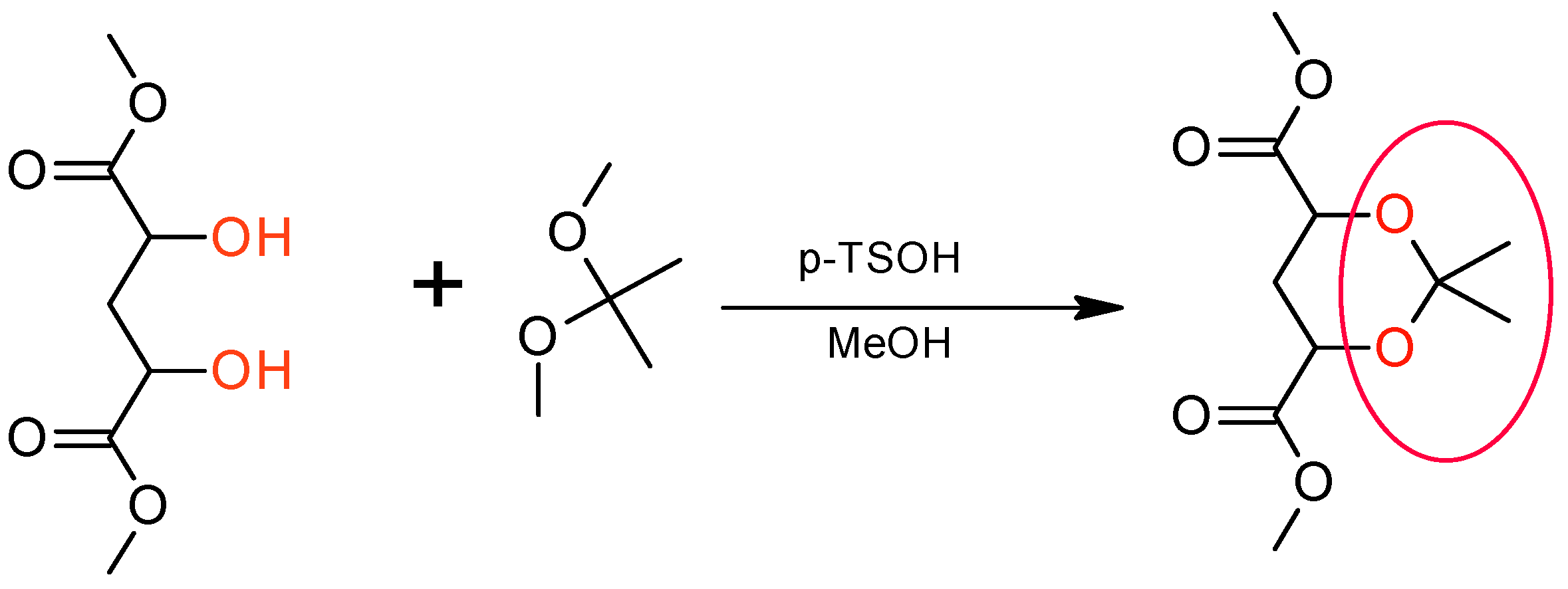

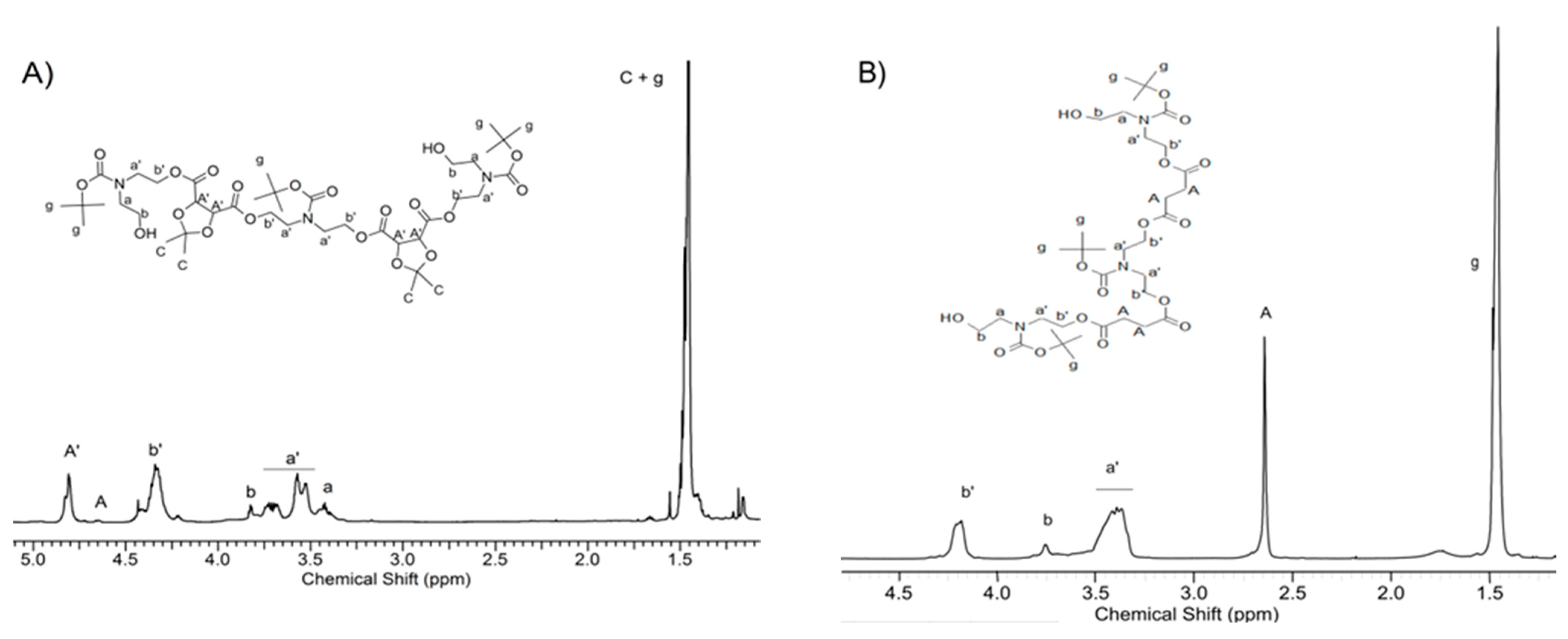
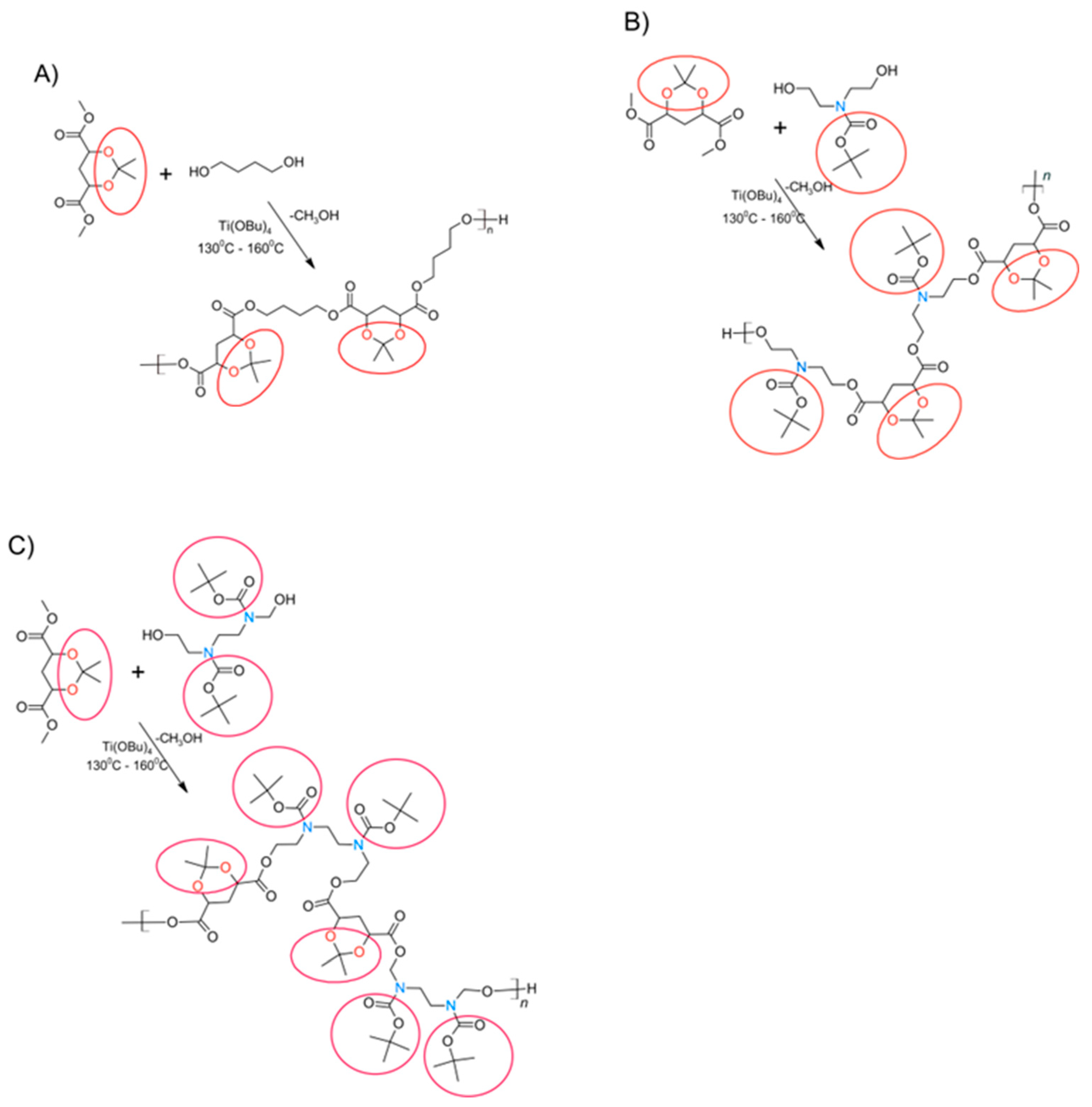


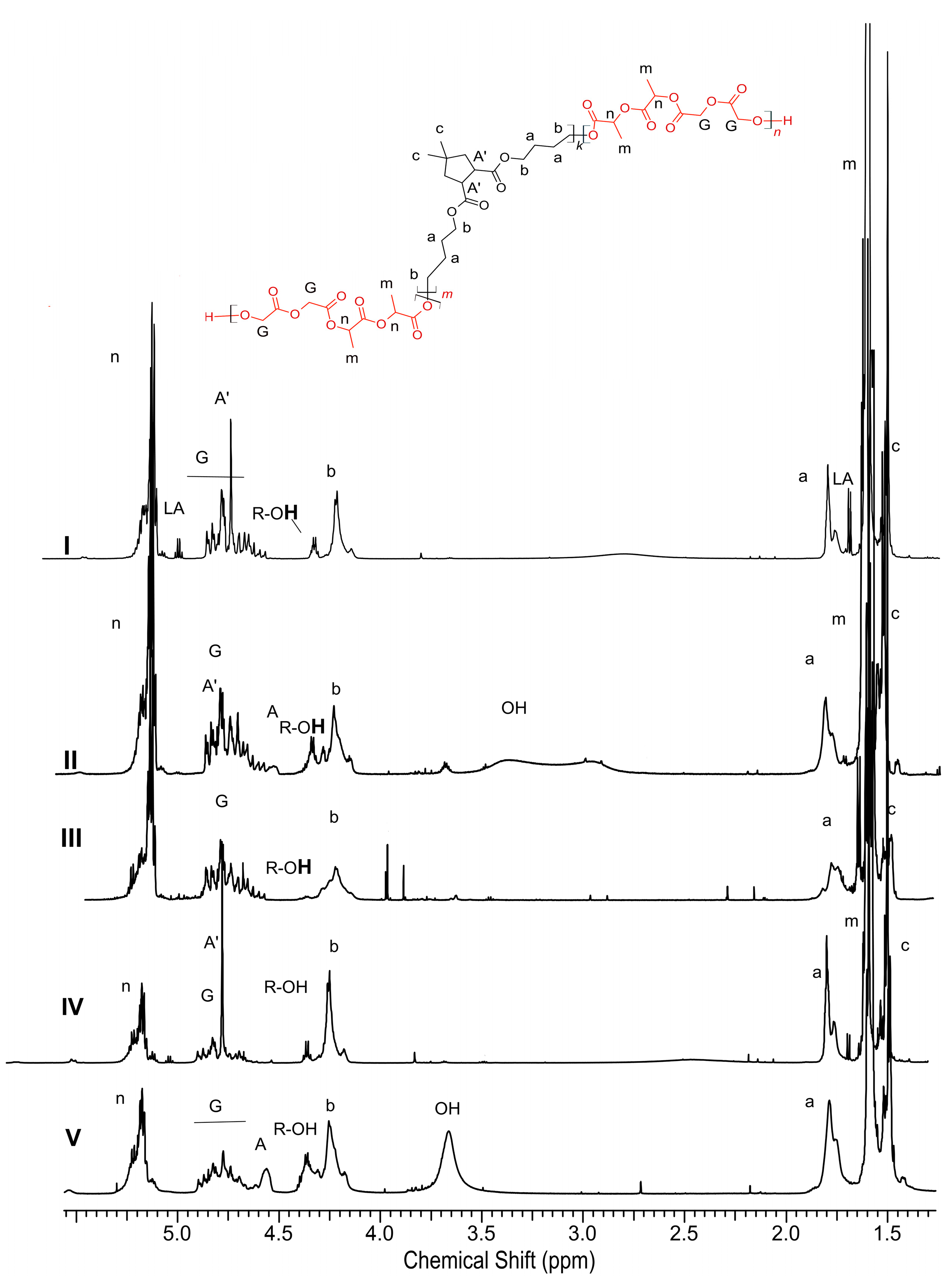
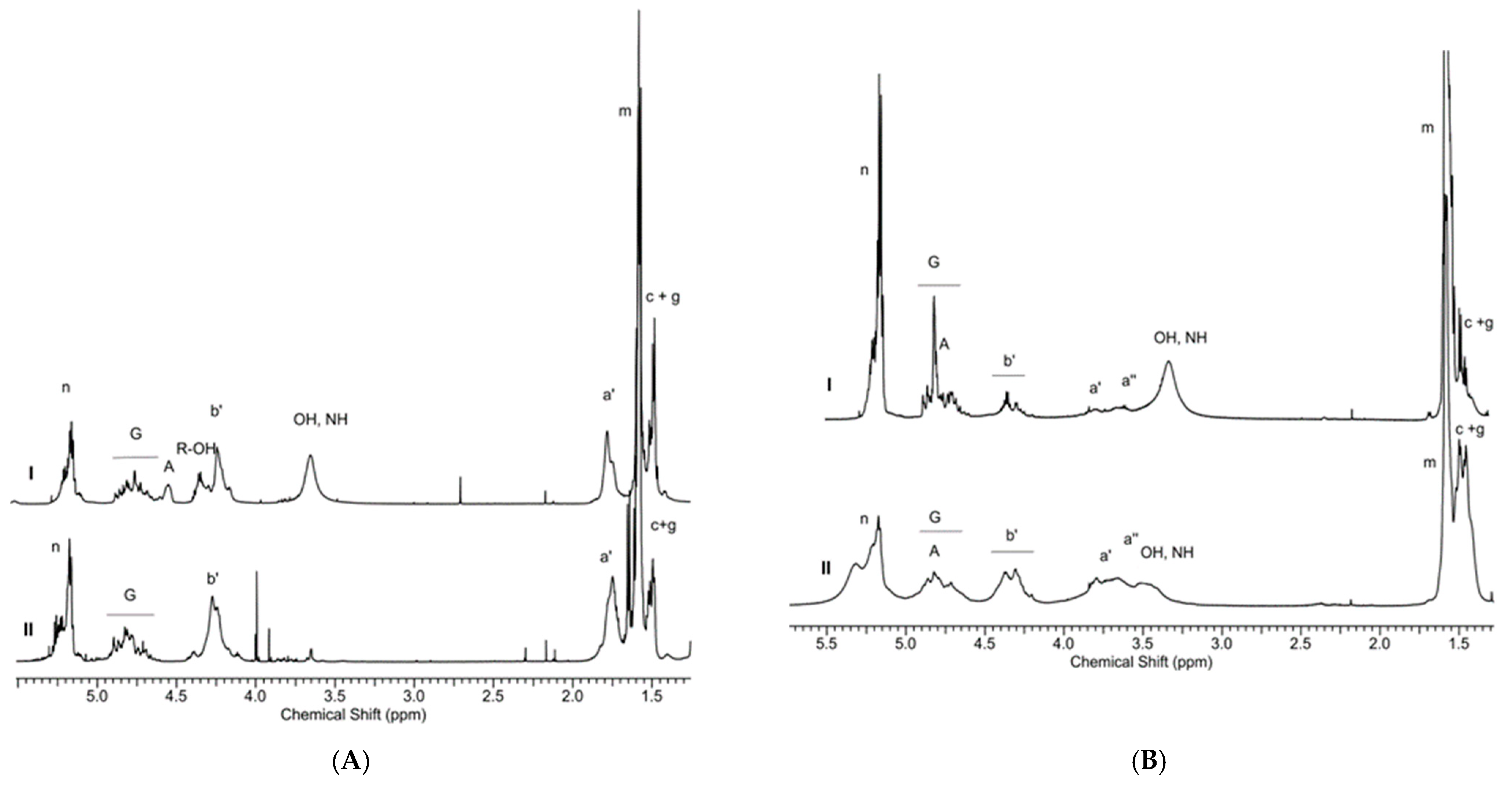
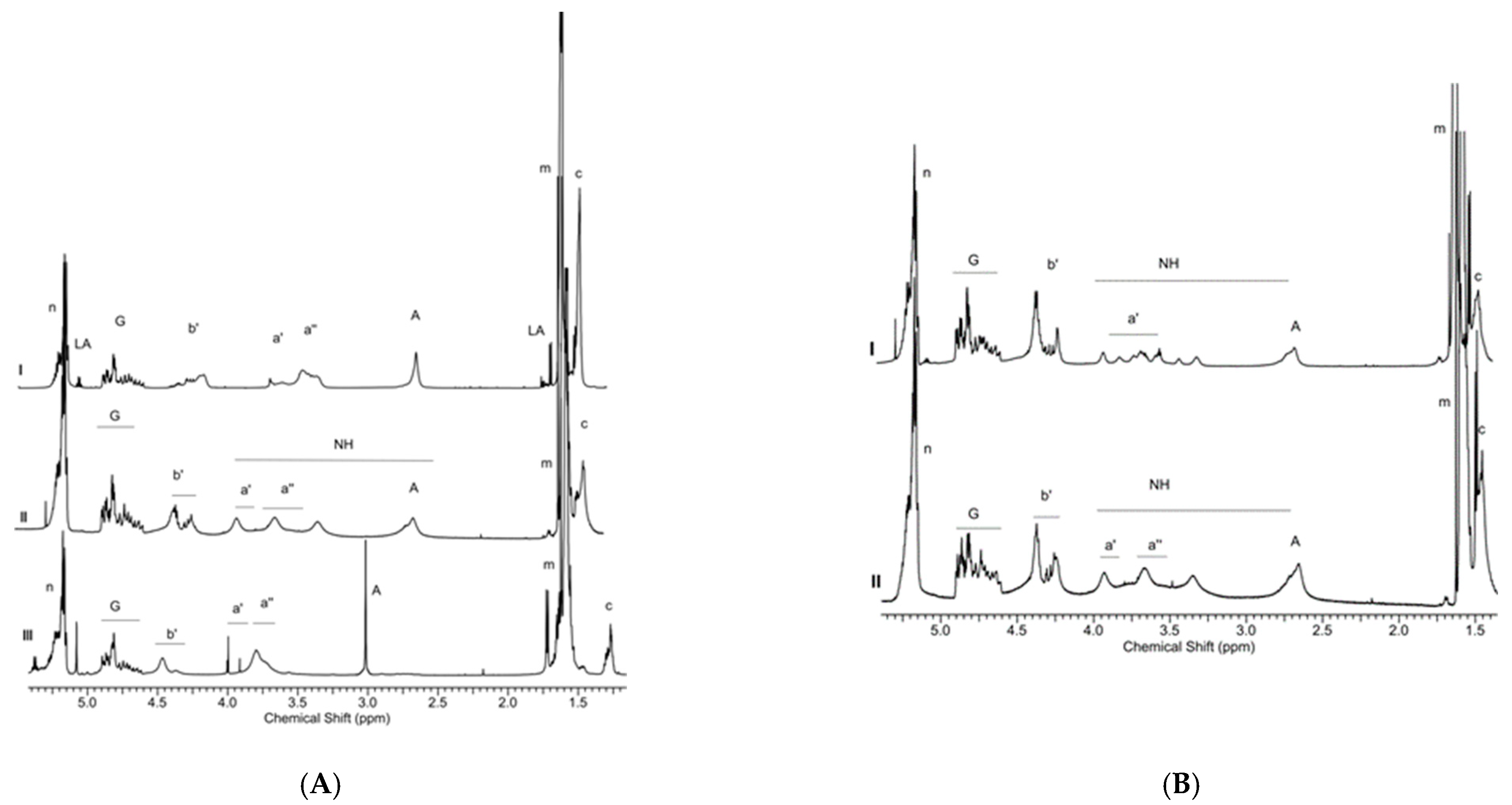
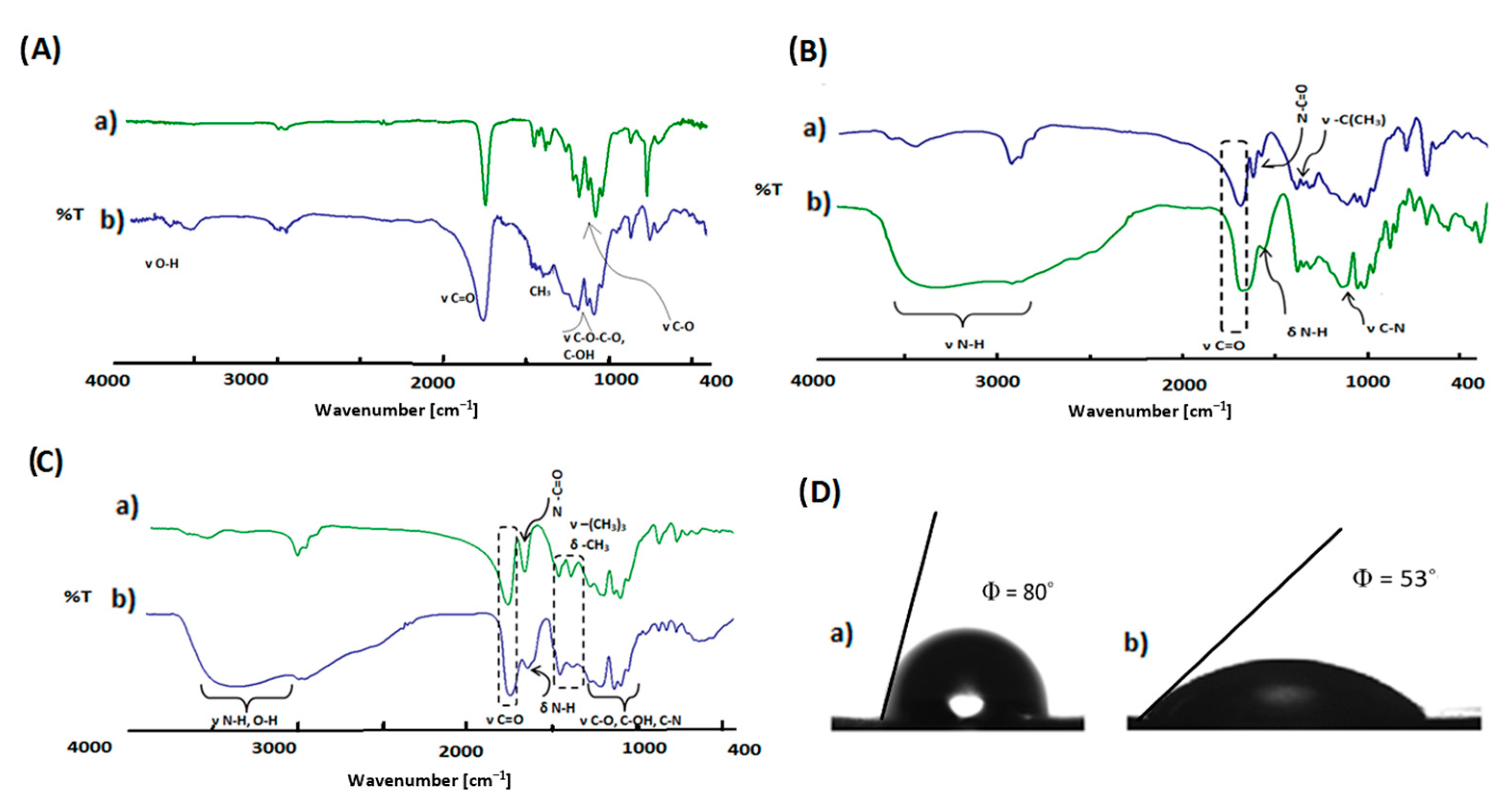

| No. | Monomers | Time (h) | NMR Mn [g/mol] (Number av. DP) | Inherent Viscosity [dL/g] |
|---|---|---|---|---|
| I1 | DIPT + BD | 15 | 7600 (26) | 0.12 |
| I2 | DIPT + BocDEA | 10 | 9000 (24) | 0.16 |
| I3 | DIPT + Boc2HEDEA | 10 | 11,400 (22) | 0.22 |
| I4 | SADE + BocDEA | 7 | 6300 (19) | 0.10 |
| I5 | SADE + Boc2HEDEA | 6 | 8900 (20) | 0.15 |
| No. | Initiator | With Protected OH and/or NH After Deprotection OH and/or NH | ||||||||||||||
|---|---|---|---|---|---|---|---|---|---|---|---|---|---|---|---|---|
| (LA:GL:I)° [%mol.] | Y [%] | (La:GL:I)c [%mol.] | Θ [°] | ηinh [dL/g] | Mw [kg/mol] | Đ | Tm [C°] | dH [J/g] | Tg [C°] | Θ [°] | ηinh [dL/g] | Tm [C°] | dH [J/g] | Tg [C°] | ||
| P1 | I1 DIPT + BD | 66:17:17 | 93 | 65:19:16 | 80 | 0.33 | 18.9 | 2.9 | 76 100 | 6.4 9.1 | 22 | 53 | 0.25 | 63 99 | 5.8 15.1 | 28 |
| P2 | I1 DIPT + BD | 57:14:29 | 91 | 54:17:29 | 78 | 0.36 | 19.8 | 2.8 | 79 | 3.7 | 20 | 50 | 0.15 | 50 | 3.8 | 21 |
| P3 | I2 DIPT + BocDEA | 66:17:17 | 88 | 62:20:18 | 71 | 0.35 | 18.2 | 3.6 | 63 | 10.1 | 37 | 50 | 0.20 | 47 | 18.1 | 38 |
| P4 | I3 DIPT + Boc2HEDEA | 66:17:17 | 86 | 61:20:19 | 70 | 0.30 | 17.9 | 4.3 | 137 | 2.8 | 32 | 48 | 0.21 | 168 | 5.1 | 31 |
| P5 | I3 DIPT + Boc2HEDEA | 57:14:29 | 84 | 53:21:26 | 62 | 0.25 | 15.5 | 4.2 | 57 131 | 4.7 1.8 | 43 | 20 | 0.18 | 110 | 33 | 36 |
| P6 | I4 SADE + BocDEA | 66:17:17 | 92 | 63:21:16 | 84 | 0.40 | 19.7 | 3.8 | 115 | 4.0 | 38 | 49 | 0.32 | 98 | 31 | 32 |
| P7 | I5 SADE + Boc2HEDEA | 66:17:17 | 94 | 65:18:17 | 80 | 0.43 | 20.6 | 2.6 | 61 90 | 4.2 15 | 36 | 36 | 0.39 | 59 100 | 16 64 | 26 |
| P8 | I4 SADE + BocDEA | 57:14:29 | 93 | 56:18:27 | 81 | 0.29 | 17.1 | 3.7 | 72 | 2.3 | 42 | 34 | 0.20 | 56 106 | 32 52 | 20 |
Disclaimer/Publisher’s Note: The statements, opinions and data contained in all publications are solely those of the individual author(s) and contributor(s) and not of MDPI and/or the editor(s). MDPI and/or the editor(s) disclaim responsibility for any injury to people or property resulting from any ideas, methods, instructions or products referred to in the content. |
© 2023 by the authors. Licensee MDPI, Basel, Switzerland. This article is an open access article distributed under the terms and conditions of the Creative Commons Attribution (CC BY) license (https://creativecommons.org/licenses/by/4.0/).
Share and Cite
Śmigiel-Gac, N.; Smola-Dmochowska, A.; Janeczek, H.; Dobrzyński, P. Biodegradable Block Poly(ester amine)s with Pendant Hydroxyl Groups for Biomedical Applications. Polymers 2023, 15, 1473. https://doi.org/10.3390/polym15061473
Śmigiel-Gac N, Smola-Dmochowska A, Janeczek H, Dobrzyński P. Biodegradable Block Poly(ester amine)s with Pendant Hydroxyl Groups for Biomedical Applications. Polymers. 2023; 15(6):1473. https://doi.org/10.3390/polym15061473
Chicago/Turabian StyleŚmigiel-Gac, Natalia, Anna Smola-Dmochowska, Henryk Janeczek, and Piotr Dobrzyński. 2023. "Biodegradable Block Poly(ester amine)s with Pendant Hydroxyl Groups for Biomedical Applications" Polymers 15, no. 6: 1473. https://doi.org/10.3390/polym15061473
APA StyleŚmigiel-Gac, N., Smola-Dmochowska, A., Janeczek, H., & Dobrzyński, P. (2023). Biodegradable Block Poly(ester amine)s with Pendant Hydroxyl Groups for Biomedical Applications. Polymers, 15(6), 1473. https://doi.org/10.3390/polym15061473







